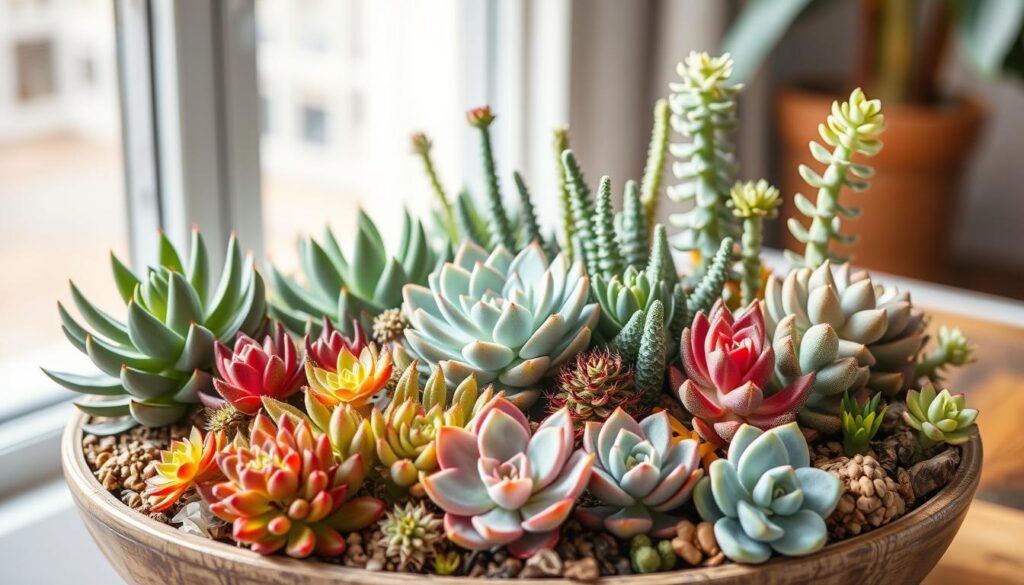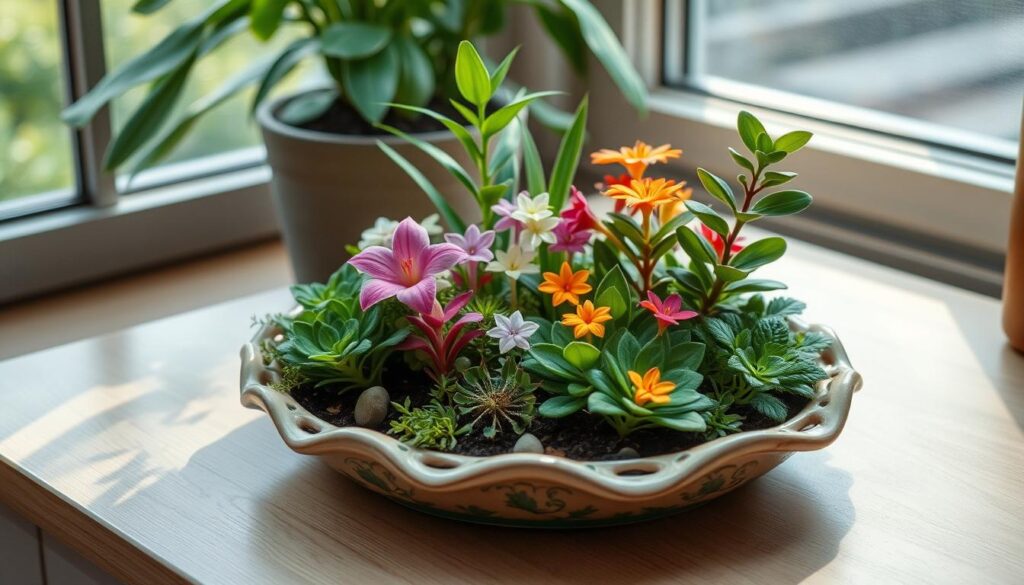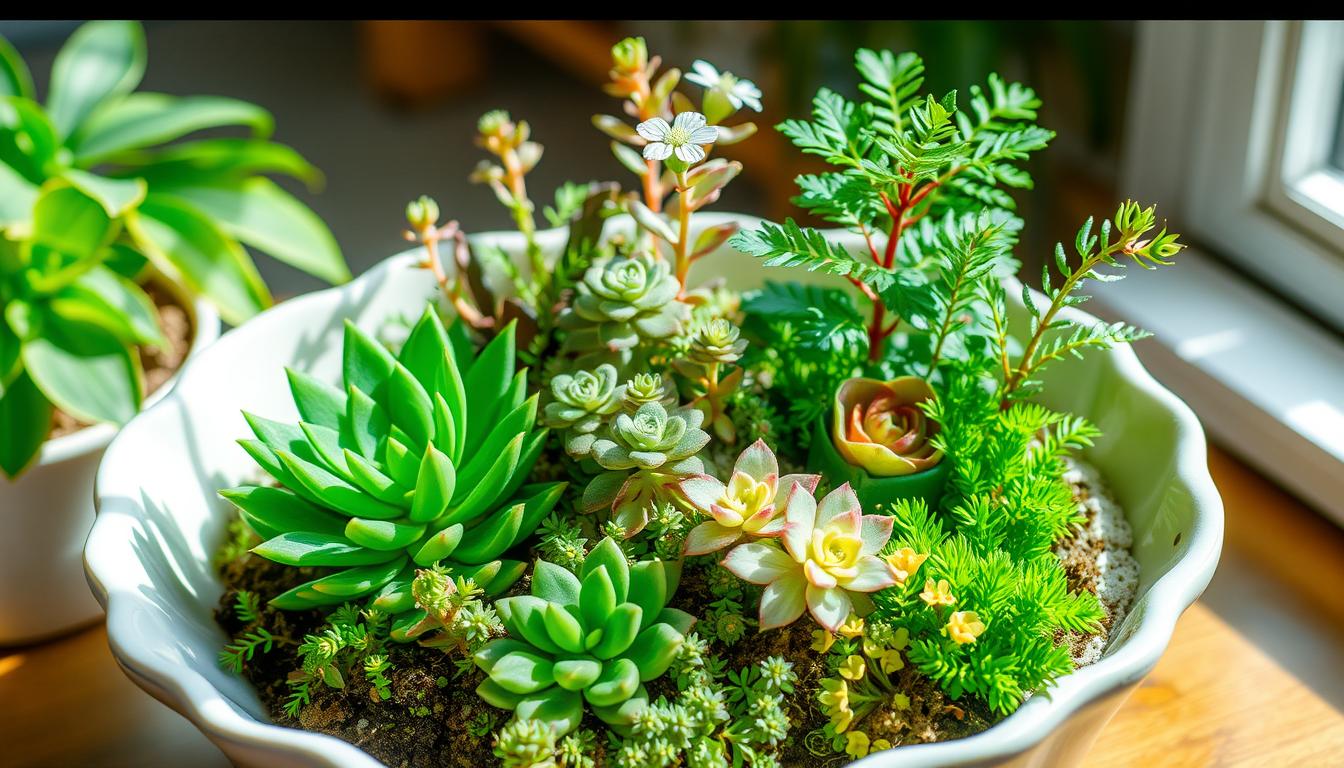As I look out the window, I dream of a peaceful place to hide from the world. That’s when I think of my indoor dish garden plants. They’ve turned my home into a lively, calming spot. These small gardens make me slow down, connect with nature, and enjoy the beauty around me.
In this article, we’ll dive into the world of indoor dish garden plants. We’ll talk about their benefits, tools, and techniques to make your own mini paradise. Whether you’re experienced or new to gardening, you’ll learn to create a thriving, easy-to-care-for indoor garden. It will bring nature’s beauty right to your hands.
Table of Contents
Understanding the Appeal of Indoor Dish Gardens
Indoor dish gardens are gaining popularity among home gardeners. They bring the beauty of nature indoors. These container gardening solutions are a unique way to grow a variety of easy-care plants in a small, eye-catching display. They are becoming a favorite garden practice for city dwellers and those with limited space.
Benefits of Mini Indoor Gardens
Dish gardens offer many benefits for indoor container gardening. They save space, allowing gardeners to enjoy a small indoor oasis. These easy-care plants also improve air quality by removing pollutants. They add a calming touch to any room.
Why Dish Gardens Are Perfect for Small Spaces
Dish gardens are great for small indoor spaces. They can fit on tabletops, shelves, or windowsills. This makes them perfect for those with little room. Plus, you can design them to match your home’s style.
Therapeutic Aspects of Indoor Gardening
Indoor dish gardens also have therapeutic benefits. Caring for these easy-care plants can be calming and meditative. It helps reduce stress. Having greenery indoors also boosts mental well-being, making them a great addition to any home.
“Nurturing a thriving indoor garden can be a deeply rewarding experience, connecting us with the natural world in a way that enhances our overall well-being.”
Essential Tools and Materials for Your Dish Garden
Creating a thriving indoor dish garden needs the right tools and materials. Whether you’re experienced or new to terrarium plants, the right equipment is key. It helps grow a lush, vibrant mini-paradise.
To start, you’ll need a few important items:
- A suitable container or dish: This can be a shallow planter, glass bowl, or even a repurposed household item with good drainage.
- Potting soil or a specialized terrarium plants soil mix: The right soil is crucial for healthy plant growth.
- A selection of small-scale, low-light terrarium plants: Choose succulents, ferns, and moss for a beautiful display.
- Decorative elements: Rocks, pebbles, or small figurines can add personality to your container gardening.
- Maintenance tools: A small pair of pruning shears, a spray bottle, and a watering can will help keep your garden thriving.
With these essential components, you’re on your way to creating a stunning indoor terrarium plants oasis. It brings nature’s beauty right to your fingertips. Enjoy the therapeutic aspects of container gardening and let your creativity shine as you design your mini paradise.
“A dish garden is a miniature world of its own, where you can cultivate a sense of peace and tranquility right in your own home.”
Selecting the Perfect Container for Your Indoor Garden
Choosing the right container is key for a thriving indoor dish garden. The container not only looks good but also affects your plants’ health. Let’s look at the important factors for picking the best container for your indoor garden.
Types of Containers Available
Dish garden plants fit well in many containers. You can pick from ceramic pots, glass terrariums, wooden planters, or even old tin cans. Each one has its own look, so think about how it will fit with your garden’s style.
Drainage Considerations
Good drainage is crucial for your plants’ health. Choose containers with holes or features that let water out. This stops waterlogging and root rot. If your container doesn’t have holes, add gravel or pebbles at the bottom to help water flow.
Size and Material Selection
The container size should match your plants. Pick one that gives enough room for the roots but isn’t too big. Also, think about the material. Terracotta breathes, while ceramic keeps temperature steady.
By choosing the right container for your container gardening, you’ll make a beautiful dish garden. It will look great and keep your plants healthy for a long time.
Best Soil Mixtures for Dish Garden Plants
Creating a thriving indoor garden practice starts with the right soil. The soil you pick can greatly affect your plants’ health and growth. It’s key for a beautiful indoor gardening space.
A mix of potting soil, perlite, and compost is a top choice for dish gardens. It balances nutrients, drainage, and aeration well. The potting soil gives nutrients, perlite helps with drainage, and compost adds organic matter.
Succulents and cacti need a different soil mix. They do best in a dry, gritty soil. A blend of cactus potting mix, sand, and small gravel or crushed rock is perfect for them.
- Potting soil-based mix: Potting soil, perlite, compost
- Succulent and cactus mix: Cactus potting mix, sand, gravel
Choosing the right soil is crucial for your plants’ health. It prevents waterlogging and root rot. The right soil sets your indoor gardening on the path to success.
“The secret to a flourishing indoor garden starts with the soil beneath your feet.”
Top Low-Light Plants for Indoor Dish Gardens
Creating a thriving indoor dish garden is easy, even in low light. Learn to grow low-light plants and turn your small space into a lush, easy-care oasis. These top picks will help you create a mini paradise in your home.
Shade-Tolerant Varieties
Choose plants that love low-light spots for your indoor garden. Some great options are:
- ZZ Plant (Zamioculcas zamiifolia)
- Chinese Evergreen (Aglaonema)
- Snake Plant (Sansevieria)
- Cast Iron Plant (Aspidistra elatior)
- Philodendron
Maintenance Requirements
Low-light plants are easy to care for. They need little water and can handle neglect. Adjust your watering based on each plant’s needs for a healthy garden.
Growth Patterns and Spacing
Think about each plant’s growth and spacing when arranging your garden. Mix different types to add interest and balance. Make sure each plant has room to grow without being crowded.
“Embrace the beauty of low-light plants and create a tranquil oasis in your own home.”
Drought-Tolerant Succulents for Your Mini Paradise
Looking to create a lush, low-maintenance indoor garden? Drought-tolerant succulents are a great choice. These plants need very little water, making them perfect for your mini indoor paradise. They add natural beauty and are easy to care for, allowing you to enjoy their vibrant colors and textures.
Some of the most popular succulents for indoor gardens include:
- Echeveria – Known for their rosette-shaped leaves and stunning color variations, Echeveria succulents come in a wide range of hues, from soft pastels to bold, saturated tones.
- Jade Plant – With its thick, fleshy leaves and distinct woody stems, the Jade Plant is a classic succulent that is easy to care for and can even grow into a small tree-like form.
- Haworthia – These compact succulents feature striking, translucent leaves that create a mesmerizing visual interest in any dish garden.
When arranging your succulents, group plants with similar growth patterns and color schemes. This creates a visually harmonious display. The low-maintenance nature of these succulents and drought-tolerant plants makes them an ideal choice for bringing natural beauty to your indoor spaces.
“Succulents are the perfect plants for those who want to enjoy the benefits of gardening without the hassle of high-maintenance care.”

Creating Beautiful Arrangements with Dish Garden Plants
Designing dish gardens is like painting with plants. It’s about picking the right plants, colors, and arranging them well. This makes your indoor space look amazing. Whether you’re new to gardening or have experience, learning about dish garden design can make your space beautiful.
Design Principles
To make a stunning dish garden, know the basics of design. Think about your container’s shape and texture. Choose plants that match it well. Use different leaf sizes, shapes, and colors to make it interesting. [https://www.kremp.com/blogs/the-kremp-florist-blog/how-to-create-floral-dish-garden-seasonal-plants]
Plant Combinations
Choosing the right plants is crucial for mini gardens. Try pairing bold succulents with delicate ferns. Match bright colors with calm ones for a nice look. Feel free to mix different plants, as long as they need the same care.
Visual Balance Tips
- Put taller plants in the middle or back for a focus.
- Use plants that spill over the edges to add depth.
- Mix plants of different heights for a lively look.
Creating mini gardens is all about having fun and being creative. Let your mini garden practice show off your style and love for indoor mini gardens.
Proper Watering Techniques for Indoor Gardens
Keeping the right moisture level is key for your indoor plants’ health. Too much or too little water can stress and even kill them. Let’s look at how to water your plants right to keep your indoor garden happy.
Frequency and Quantity
The amount of water your plants need changes based on several things. These include the container size, plant type, and your home’s conditions. Generally, water when the top inch or two of soil feels dry.
- Water your plants once a week, but adjust based on growth and environment.
- Water enough to moisten the soil well, but don’t make it too wet.
- Use a watering can or squeeze bottle to water the soil gently, avoiding leaf splashes.
Identifying Watering Issues
Watching your plants closely helps you catch watering problems early. Look for these signs:
- Wilting or drooping leaves mean they need more water. Yellowing or mushy leaves suggest too much water.
- Check soil moisture by sticking your finger in. If it’s dry a few inches down, water. If it’s always wet, change your watering schedule.
“The key to successful indoor dish gardening is finding the right balance between moisture and drainage. With a little practice, you’ll get to know your plants’ needs and create the perfect growing conditions.”
By using these watering tips, your indoor plants will flourish. They’ll help make your space calm and healing.
Maintenance Tips for Long-Lasting Dish Gardens
Creating a thriving indoor dish garden is rewarding. But, keeping it healthy for a long time needs some effort. This section will guide you on how to keep your mini paradise lush and vibrant for years.
Pruning Guidelines
Pruning is key for your dish garden’s health. Use clean, sharp scissors to trim dead, damaged, or overgrown leaves. This keeps your plants looking good and encourages new growth.
Prune just above healthy leaves or buds for a neat look. This helps prevent pests and diseases.
Fertilization Schedule
Dish garden plants need regular fertilization. Use a balanced, water-soluble fertilizer every 4-6 weeks during the growing season. Follow the instructions carefully to keep your plants healthy and growing.
Pest Management
Dish gardens can get pests, even indoors. Check your plants often for signs of insects like aphids or spider mites. If you find pests, quickly wipe the affected leaves with a damp cloth or use insecticidal soap.
Keeping your garden clean and well-ventilated helps prevent pests. This way, your mini garden stays a peaceful oasis for years.

Seasonal Care for Your Indoor Mini Garden
Keeping an indoor mini garden alive means changing how you care for it with the seasons. Light, temperature, and humidity change all year. So, your indoor gardening needs to change too, to keep your mini gardens looking great.
In the colder, darker months, water your plants less. They need less water when it’s cold. But when spring comes, water them more to help them grow. Make sure the soil drains well and check it often to avoid too much water.
Changing the light your plants get is also key. In winter, use grow lights to help them grow. When it gets lighter in spring and summer, move your plants to brighter spots. This helps them get the light they need.
- Refresh your mini gardens seasonally to keep them interesting and healthy.
- Change how often you water, feed, and prune your plants with the seasons.
- Move your indoor gardening spots to get the best light all year.
By paying attention to what your mini gardens need each season, you can keep them thriving. This way, your indoor gardening space stays lively and beautiful all year.
Troubleshooting Common Dish Garden Problems
Keeping an indoor dish garden healthy can be rewarding but comes with challenges. Knowing how to tackle common problems helps keep your garden vibrant. Let’s look at some common issues and how to solve them to keep your plants thriving.
Plant Health Issues
Pests and diseases can harm your indoor plants. It’s crucial to watch for signs of trouble early. Look for pests like aphids, mealybugs, or spider mites and use safe pest control. Also, watch for disease signs like discoloration, wilting, or rotting, and fix the problem quickly.
Environmental Challenges
The indoor environment can be tough for plants. Wrong lighting, temperature changes, and too much or too little water can stress them. Make sure your plants get the right amount of light and keep the temperature and humidity steady. Adjust your watering to keep the soil just right.
Solutions and Prevention
- Regularly check your plants for pests or disease and act fast.
- Give your plants the right conditions, like good light, temperature, and humidity.
- Water your plants consistently, adjusting as needed.
- Use organic fertilizers or compost to feed your plants.
- Prune and trim plants to keep them healthy and prevent overcrowding.
By being proactive and addressing problems early, your indoor garden can stay lush and vibrant. With proper care, your mini paradise will flourish and bring joy for years.
“A healthy dish garden is a reflection of the care and attention you give to your indoor plants.”
Conclusion
Creating an indoor dish garden is a fun way to make a small paradise at home. You’ve learned how to pick, arrange, and care for plants. This knowledge helps turn any space into a lush oasis.
Dish gardens are great for those who love gardening or want to add beauty to their homes. They’re easy to care for and can include plants that love shade or dry soil. This way, you can have a peaceful mini paradise indoors.
Starting your own indoor dish garden plants is exciting. It’s about connecting with nature and trying out different plants. With creativity and the right tools, you can make any part of your home a beautiful mini paradise.

